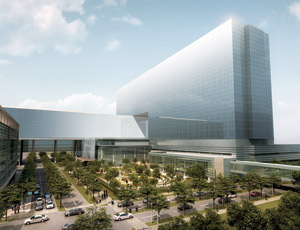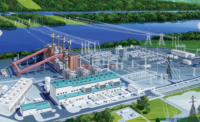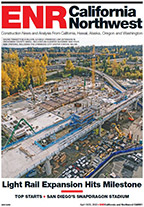While public projects dominate Texas and Louisiana's more than $10 billion in Top Starts for 2010, a smattering of private jobs also were able to secure enough backing to move forward.

Projects associated with transportation, health care and the rebuilding of New Orleans infused billions into the region's construction market. Owners have embraced innovative approaches in financing, construction techniques and design to deliver needed infrastructure at a reasonable cost.
Dallas-Fort Worth is key market
Three of the top five project starts—the North Tarrant Expressway, the new Parkland Hospital and the DFW Connector—are under way in the Dallas-Fort Worth area, which enjoys a healthy share of private work. Leading institutional jobs there are Museum Tower, a 42-story residential project, and the Perot Museum of Nature and Science. Both are owner-financed and among Texas' top 10 largest project starts.
The Dallas Police and Fire Pension System has a $200-million stake in Museum Tower as “an investment in the hometown of the men and women who serve and protect the city,” says the system's board in a written statement. A spokesman for Austin Commercial, the project contractor, says the recession helped it secure favorable prices, and that steel and concrete availability has kept the owner satisfied with costs.
Strong financial support from donors also propelled the Dallas Museum of Nature and Science's plans for a new museum. So far, these include a $50-million gift from the family of H. Ross Perot, $25 million from the Rees-Jones Foundation, $10 million from T. Boone Pickens and $65 million from a variety of other contributors. Donations also enabled the $105-million Amon G. Carter Stadium redevelopment at Texas Christian University in Fort Worth to start last year.
Rounding out the top 25 are a variety of projects, including the Pinnacle Baton Rouge Hotel & Casino, which will be moored atop a levee to steel pipe piles and caps; the George W. Bush Presidential Center in Dallas; the Galveston Causeway Railroad Bridge, featuring a main span built off site and floated into place; and numerous education projects.
Transportation Takes Off
Six of the top 25 starts are Texas road or bridge projects. “The infrastructure we have for transportation in Texas is vitally important to the state's ability to attract and retain businesses and new residents,” says John Barton, assistant executive director for engineering operations at the Texas Dept. of Transportation (TxDOT).
The projects also underscore the state's commitment to handle its growth with innovative financing. The two largest transportation projects—the North Tarrant Expressway and the DFW Connector—take advantage of the private sector's interest in partnering. Development agreements allowed TxDOT and regional authorities to finance and begin projects faster than if they had to wait for traditional funding.
“In metropolitan areas where we have congestion growing, communities say they were willing to build toll roads paid for through a combination of traditional bonds and public-private partnerships,” Barton says.
As federal funding became more difficult to secure, the state Legislature allowed TxDOT to issue debt backed by fuel taxes and general revenue, benefiting projects during the past year, Barton notes.
“In 2007, the vast majority of voters in Texas indicated they believe transportation is so important that they were willing to have some general revenue used to pay off up to $5 billion worth of debt,” he says. TxDOT is using about $2 billion of that to advance projects around the state, including the widening of I-35 in Bell County, a top 25 project. The North Texas Tollway Authority is building the State Highway 161 toll road, also using federal stimulus funds.
Health Care Booms
Dallas residents also recognize the need for good health care in facilities incorporating new technology. In 2008, 82% of voters approved a $747-million bond program to build the new Parkland Hospital, which tops the starts list for vertical projects. Public funds have contributed nearly $100 million toward a $150-million capital campaign.
“It confirms the appreciation from the community for the services they have received from Parkland,” says Walter B. Jones Jr., the hospital's senior vice president of facilities planning and development. In using public funds, Parkland has looked for ways to stretch construction dollars.
The 17-story facility features separate medical and women's services hospitals, a logistics building, a parking garage and a central energy plant. A joint venture of Balfour Beatty Construction, Austin Commercial, H.J. Russell & Co. and Azteca Enterprises, all of Dallas, is building the hospital.
Early in the master planning, Parkland officials worked with Dallas Area Rapid Transit to place a Green Line station at the hospital complex, the first time a U.S. hospital construction project has included a rapid transit station, according to Christopher Guice, a spokesman for Austin Commercial'. He says coordination between work on the two projects is key.
Parkland also is making use of prefabrication, Jones says. Its 865 rooms are identical, which means some work can be done off site, he notes. Details remain to be worked out, but the team is considering prefabricating bathroom modules and overhead HVAC, piping and electrical infrastructure, he adds.
Jones says the approach would boost unit quality as well as work-force productivity and safety. “The real economy comes into play by correctly judging the material to be used, so there is less waste,” Jones says. “Time is money, and it could save time. And quality dovetails into potential cost savings.” The exterior will feature a prefabricated, unitized curtain wall system, eliminating the need for exterior scaffolding, project officials say. Crews will stay in the building to attach it.
Article toolbar


Post a comment to this article
Report Abusive Comment